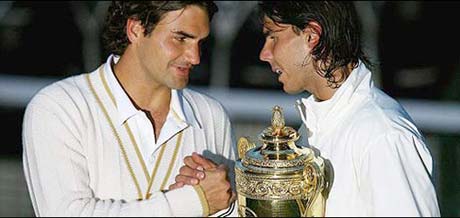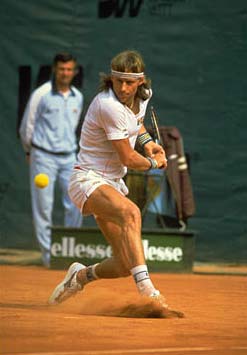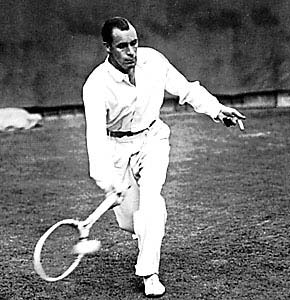|
TennisOne Lessons What Wimbledon Statistics Reveal When asked last year what his greatest strengths are, 12-time Grand Slam titlist Roger Federer replied, “My forehand and my speed.” Those formidable assets and others − such as his serve, volley, overhead, stamina, strategy, poise, competitiveness and athleticism − weren’t quite enough, though, against Rafael Nadal in the extraordinary Wimbledon final that many, including myself, consider the greatest tennis match ever. Let’s look at the most pertinent statistics and analyze why.
Break Points How often a player converts his break point chances − especially if they come in several different games − is one of the most important match stats because it often makes the difference between winning and losing sets and matches. Federer converted only 1 of 17 break points against Nadal in the 2007 French Open final; and Federer was 1 for 4 when he was thrashed 6-1, 6-3, 6-0 by his archrival in the 2008 French Open final. Much like a football team that gets pushed around the field but stiffens its defense just in time to prevent the other team from scoring, Nadal bends but rarely breaks on his service games. During his 123 Wimbledon service games, he won his service games a superlative 118 times. At Wimbledon where he was slightly favored to win his sixth straight title, Federer, one of the best clutch players in tennis history, shockingly won only 1 of 13 break points. In some cases, such as the pivotal tenth game of the opening set which Nadal captured 6-4, the 22-year-old Spaniard saved a break point by forcing an error (backhand volley). In other cases, such as four points later in the same game, Federer ruined a break point opportunity with a bad backhand service return error. Federer had three more precious chances to break serve in three different games in the second set, which he also lost 6-4. He converted the first one with a forehand passing shot to go ahead 2-0. But, again in the crucial tenth game, Nadal escaped another break point by forcing Federer into a backhand error. In the ladies’ singles event, Serena Williams lost to big sis Venus 7-5, 6-4 for the same reason: she converted only 2 of 13 break point chances. In fairness, five of those chances came in the protracted (20-point) third game of the second set in which Serena did eventually get the service break. Also, Venus saved several other Surprise semifinalist Jie Zheng of China, coming back from an injury-plagued 2007 and ranked a misleading No. 133, often played her best when it counted most − on break point opportunities − to pull three upsets. Zheng shocked No. 1 Ana Ivanovic 6-1, 6-4, succeeding on 4 of 7 break points; eliminated No. 15 Agnes Szavay 6-3, 6-4, converting 3 of 7 break points; and then beat No. 18 Nicole Vaidisova 6-2, 5-7, 6-1 by winning 5 of 10 break points.
Net Approaches In 2003 Federer won his first Wimbledon crown, culminating with an easy straight-sets final triumph over Mark Philippoussis, by serving and volleying almost all the time on his first serve and about half the time on his second serve. Since then, however, he’s become a groundstroke-and-volleyer who almost never serves and volleys. In this year’s final, Nadal’s powerful and pinpoint passing shots allowed Federer, an athletic but not excellent volleyer in the Edberg or Rafter class, to win points on only 56 percent (42 of 75) of his forays to the net. In contrast, Nadal has broadened − not narrowed − his grass court skills. In his 2003 Wimbledon debut at 17, he became the youngest male player to reach the third round since 16-year-old Boris Becker in 1984. However, Nadal readily acknowledged that his then one-dimensional game was more suited to clay than fast grass courts. Although Nadal has always been considered a baseliner, he has successfully mastered grass court tennis, much like five-time Wimbledon winner Bjorn Borg, another Western-style player 30 years ago. Nadal now positions himself much closer to the baseline, his volley technique is superior to Borg’s, and his positioning, reflexes, anticipation and confidence at net are topnotch. Against Federer, he won 71 percent (22 of 31) of the points when he approached net. In fact, for the entire fortnight, Nadal won a remarkable 77 percent (103 of 134) of the points at net. Those impressive numbers suggest he should come to net more often both to finish off foes faster and to reduce the stress on his injury-prone knees. Serving Success A natural right-hander, Nadal doesn’t yet have the booming serve that his muscular 6’1”, 188-pound physique should produce regularly. That said, this “relative weakness” in his repertoire keeps getting stronger. In the Wimbledon final, Nadal fired only six aces (compared to Federer’s 25), but he averaged a respectable 113 mph on his first serve (compared to Federer’s 118 mph). That serving speed improved on Nadal’s 107.5 mph average in the French Open final four weeks earlier.
Despite a stance that is too narrow and open and thus reduces his weight transfer as well as his hip and shoulder rotation, Nadal’s fastest serve in the final was 126 mph, and in his six previous matches, was 127, 126, 125, 127, 128 and 122, respectively. His average first serve speed in those six matches was 114, 116, 113, 118, 119, and 116, respectively. In other pro matches, Nadal has occasionally surpassed 130 mph. Those numbers lead to the inescapable conclusion that Nadal, who early in his pro career thought of the serve as a required means to start the point, should now think of it as an explosive means to end the point. That said, Nadal’s serve is already far more effective than his mere six aces in 30 service games and two tiebreakers indicated. That’s because Federer did not return his first and second serve 43 other times. The most telling of all the service stats is that of those 49 total unreturnable serves, 12 came on game points, enabling Nadal to hold serve, all but once in the entire match. And unlike the French final where Nadal served almost exclusively to Federer’s vulnerable backhand, a more confident, ambitious Nadal served into Federer’s body and to his awesome forehand with a variety of slice and kick serves to keep the Swiss guessing and off balance. Percentage Tennis
Although Nadal doesn’t serve as fast as Federer, his first serve percentage of 73 was better than Federer’s 66 in the final. That high percentage was not an aberration because Nadal averaged 72 percent for the Wimbledon fortnight. Much like the official scoring in baseball for hits and errors, not everyone agrees on what should be considered “unforced errors.” After all, today’s players hit the ball so hard and accurately that there are actually few easy situations. I advocate creating a third category − in addition to “forced errors” and “unforced errors” − called “semi-forced errors” because that would accurately describe many errors. In any event, Nadal almost always has far fewer unforced errors than his opponents. In the Wimbledon final, Nadal committed only 27 to Federer’s 52. Throughout the championships, Nadal maintained that same 52 percent (106 to 204) of all his opponents’ unforced errors. Eighty years ago, “Big Bill” Tilden declared a famous dictum: “Tennis matches aren’t won on winners. They are lost on errors.” That wisdom has stood the test of time, though in that bygone era no distinction was made between forced and unforced errors, and today some pro matches produce more winners (including service winners and aces) than unforced errors. Tiebreaker Tests Perhaps Nadal should consider himself lucky that Wimbledon does not use a tiebreaker in the deciding set. (This year the thrilling 9-7 fifth set was good fortune for him and great theater for fans.) That’s because The Mighty Fed is at his mightiest in tiebreakers; he boasts a sensational 24-3 record in Wimbledon tiebreakers since 2003. On the brink of defeat, Federer calmly smacked four aces to win the third set tiebreaker 7-5. Still fighting for survival in the fourth set tiebreaker, Federer belted four forehand winners to escape 10-8. But it was a dazzling down-the-line backhand passing shot on championship point at 7-8 that kept him alive.
Much like Borg who didn’t lose heart or confidence after losing the famous 18-16 fourth-set tiebreaker against McEnroe in the memorable 1980 Wimbledon final, Nadal showed his skill, will and stamina by regrouping to seize the climactic set for an riveting 6-4, 6-4, 6-7, 6-7, 9-7 victory. German legend and three-time Wimbledon titlist Boris Becker commented: “I’ve never seen a final that was so nail-biting, but the right player won and it signals a changing of the guard.” Some things can’t be measured in numbers, though. No stat can adequately capture the breathtaking shotmaking throughout this classic, which three-time Wimbledon champion John McEnroe called “the greatest match I’ve ever seen.” Nor can stats describe the grace and humility Nadal and Federer displayed in victory and defeat. As former world No. 1 Jim Courier, on the “Charlie Rose” program, said, “Have you ever seen two rivals in a one-on-one sport, throughout the combat where these champions are putting their lives on the line, have more respect and appreciation for each other and better sportsmanship?” These role models, though not American heroes, could nonetheless help instill much-needed sportsmanship in U.S. sports and induce parents to have their children play tennis. A recent national survey, released by the Awards and Recognition Association and market research firm TNS, found that more than 85 percent of Americans 20 and older think sportsmanship is worse now than when they were growing up. * * * Best Wimbledon Statistic: In 1971, when John Newcombe and Evonne Goolagong were champions, 46 Australians were in the gentlemen’s and ladies’ singles draws at Wimbledon. In 2008, the singles draws contained five Aussies, two men and three women. Best Wimbledon Quote: “With a sibling rivalry, it’s like, I personally want everything that Venus has. So, she wins a trophy, I would desperately want it. We’re good at this now. We just leave everything out on the court. This is the finals of Wimbledon. Who doesn’t want it? This is a Grand Slam. It’s history. We both are trying to make our mark,” said Serena Williams, before losing 7-5, 6-4 to her sister Venus in the Wimbledon final. Your comments are welcome. Let us know what you think about Paul Fein's article by emailing us here at TennisOne.
Paul Fein Paul Fein, a USPTA teaching pro and former top 10-ranked New England men’s open player, has won more than 20 writing awards. His 2002 book, Tennis Confidential: Today’s Greatest Players, Matches, and Controversies, published by Brassey’s, Inc., was listed No. 1 among tennis books by Amazon.com and BN.com. Information about the book and how to order it can be found at www.tennisconfidential.com. His second book, You Can Quote Me on That: Greatest Tennis Quips, Insights, and Zingers, was published by Potomac Books, Inc. (formerly Brassey’s, Inc.) in 2005 and was listed No. 1 among tennis books by Amazon.com and BN.com. For more information, visit www.tennisquotes.com. His third book, Tennis Confidential II: More of Today’s Greatest Players, Matches, and Controversies, was published April 28, 2008 and was featured on the home page of Amazon.com. |



 Eighty years ago, “Big Bill” Tilden declared a famous dictum: “Tennis matches aren’t won on winners. They are lost on errors.” That holds true today also.
Eighty years ago, “Big Bill” Tilden declared a famous dictum: “Tennis matches aren’t won on winners. They are lost on errors.” That holds true today also.